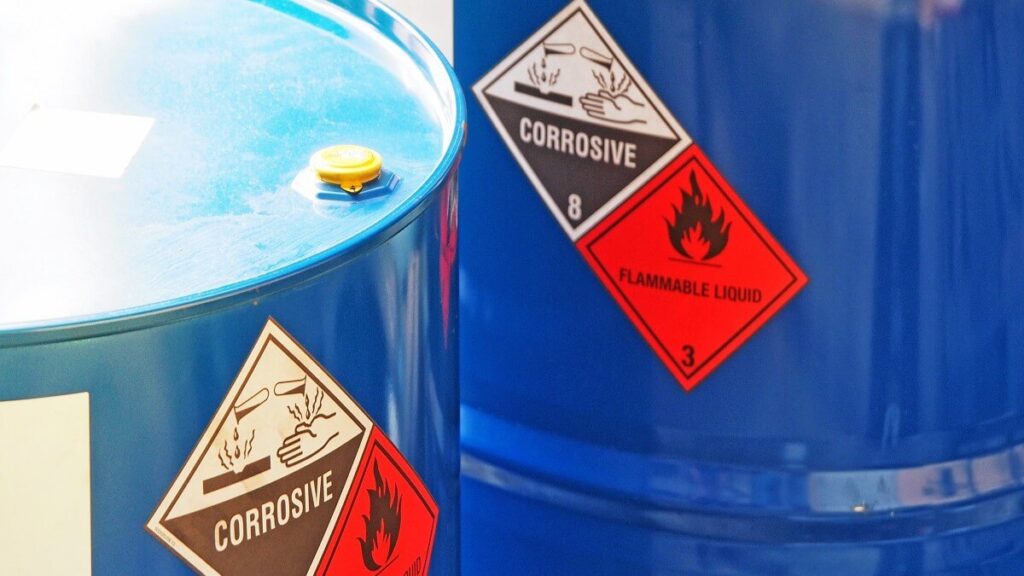Behind the Scenes: The Journey of a Specialty Chemical from Concept to Commercialization
- May 31, 2024
- Blog
In the highly competitive, complex market of specialty chemicals, the development process is much more directly tied to profitability than for commodity chemicals, which benefit more from bulk transactions and streamlined logistics.
We describe the path a specialty chemical may take below but the journey of your surfactant, industrial cleaner, fragrance, or specialty polymer can vary significantly.
To optimize the results of this journey, your best bet is teaming up with a proven chemical manufacturer.
Seatex is an experienced partner of specialty chemical developers, with the physical assets and mechanical capabilities to handle the toughest R&D and production challenges companies face.
1. Research and Development: The Journey Begins
Market Analysis

A company may launch a new specialty chemical to satisfy a demand for a chemical that’s greener, better quality, compliant with new regulations, or able to turn a waste stream into a revenue stream.
Whatever the motivation, because of their narrow range of applications, it’s likely that the market research needed to identify opportunities in a particular niche will have to be more in-depth than that for a standard chemical.
This may include lab testing–using the same or similar methods to assess a potential new formulation later on–to analyze the strengths and weaknesses of currently available products on the market, and technology-driven tools such as big data.
But don’t overlook the importance of the simple things like talking to your customers and asking them what their pain points are as it relates to the chemical products they use.
Formulating Chemical Concepts
With the potential market niche identified, chemical developers must now iterate the means–the properties and the performance–by which the product will achieve its objective. Depending on the application, the performance may not need to be novel but only the composition (to avoid patent infringement).
For example, in the herbicide market there are well-established “modes of action,” or strategies used to disrupt a weed’s biological processes, that more than one product on the market may utilize. Incidentally, this can lead to plants that are resistant to particular modes of action, necessitating new specialty herbicides.
Thus, chemical manufacturers have to return to the drawing board to brainstorm, test hypotheses, and experiment with various combinations and reaction pathways in pursuit of a new formulation.
Lab Testing
The potential success of a new formulation will become much clearer after this stage. Using chemical analysis techniques the lab technicians may evaluate the product’s moisture content, combustibility, viscosity, reactivity, solubility, and more.
Based on the results, the product may have to return to the concept stage for refining or, if it passes the benchmark criteria set by the developers, it advances out of R&D and into production.
The amount of refining necessary varies greatly by industry; for example, pharmaceuticals are notorious for their lengthy development times, but other types of products can make it to market faster.
2. Pilot Scale-Up: Moving from the Lab to the Real World
Pilot scale production is the stage that ‘makes or breaks’ many specialty chemicals.
It’s in this phase that developers determine whether what worked in tiny batches in the lab can be replicated in larger quantities, and if it will be profitable to do so. They’re looking for a process that’s easily replicated and predictable and produces a final result that meets all regulatory requirements.
The difficulty lies in the fact that changing the desired volume of the chemical often changes the dynamics of the lab-derived process.
Pressure, heat transfer, mixing, the development of unwanted foam, and other aspects may transgress the parameters set by the developers for their product, requiring engineering ingenuity and/or chemical expertise to bring them back into acceptable ranges.
Scale-up research is commonly done in a temporary pilot plant as a way to avoid sinking capital into a full-scale facility before mass production of a new chemical is proven viable.
Nevertheless, pilot plants, their equipment, and the trained personnel to operate them typically come at a high cost, especially for specialty chemical manufacturing. Thus, the design of the pilot plant can have a dramatic impact on the outcome of the testing: a poorly designed plant can create delays, increase costs, endanger staff, or even skew results and threaten the success of the entire project.
A key task in this stage is the production cost analysis, which may be done once the chemical process is finalized to help the developers ballpark how much capital will be needed to fully launch the product given the estimated energy, operation, maintenance, and infrastructure costs.
Tip: Use a manufacturing partner as a co-pilot.
Specialty chemical manufacturing professionals like those at Seatex can handle your pilot plant in-house, with the equipment and technicians needed already there. The former may include large tanks, mixers, ventilation systems, or other gear that a chemical owner would otherwise have to buy for itself. Plus, a specialty chemical manufacturer can collaborate with you to help optimize the production process, source raw materials, and more.
Learn more about selecting a chemical manufacturing partner here.
3. Regulatory Compliance and Safety: The Last Hurdle

Depending on where you intend to market your specialty chemical, it could be subject to a number of governmental health and environmental regulations, from California’s Proposition 65 to the U.S.’ Consumer Product Safety Improvement Act (CPSIA) to Europe’s REACH.
To ensure compliance and avoid heavy penalties, your product may need to undergo testing for the presence or levels of hazardous substances such as lead, cadmium, or phthalates. Because of the unique nature of some specialty chemicals, this testing may need to be more expansive than for commodity chemicals as the performance and behavior is less understood.
The production process can inadvertently introduce contaminants into the final product, and it can introduce pollutants into the air and run afoul of the Environmental Protection Agency or OSHA.
Chemical testing, X-ray fluorescence (XRF) screening, and other tests can help detect trace contamination. To protect the air quality for your workers and the surrounding community, the manufacturing facility may need to have oxidizers and/or concentrators installed.
Did you know?
A single rule change by the EPA in Spring 2024 tightened emissions restrictions at over 200 U.S. chemical plants. A good manufacturing partner with applicable certifications and a strong safety record can help you navigate regulatory requirements and ensure ongoing compliance with safety, environmental, and quality standards even as they change.
4. Commercial Scale Production: Preparing to Hit the Market
At this point, you’re ready to switch to full-scale production–and the larger facilities and greater amount of equipment that entails. Also called scale-up, this may be a drawn-out process of expansion over several months or even years as, ideally, demand grows and capital becomes available to invest into more infrastructure. But equally important is the flexibility to react to changes in production volume or mix, or a decline in market demand.
How equipped is Seatex?
With over 40 stainless and poly vessels ranging from 100 to 15,000 gallons each; 65 bulk holding tanks for raw material and finished goods inventory; and ISO 9001:2015, GMP, EPA, NSF, Kosher, and UL blending certifications, we’re ready to scale as high as you want to go while maintaining top quality.
The manufacturing process may also continue to evolve as you tweak the conditions or parameters of manufacturing at greater volume.
As the manufacturing process is optimized, quality management processes are established to verify the product’s reliability and safety. Many manufacturers seek and obtain quality management certification such as ISO 9001 to verify the soundness of their quality control processes.


At the commercial production level, your supply chains for raw, intermediate, and finished products are also put into place.
You and/or your manufacturer determine the optimal packaging size or sizes, as well as their configuration and labeling. Specialty chemicals often demand custom container designs to facilitate their unique use, and they may also require hazardous chemical labeling. A manufacturing partner like Seatex is well-versed in chemical packaging and labeling.
5. Commercialization: Business Development and Market Launch
You’re almost ready to send your new product out into the world, but before you do, safeguards for your IP will need to be put in place.
If applicable, you should file for a patent before pitching to investors or offering the product for sale. Although it may very well be upwards of two years before the patent is awarded, waiting until as late as possible should afford you the best protection based on the specifics of your product’s mode of action and/or make-up, while still allowing you to market the product as “patent pending.” And you should consider IP protection in each country where the product will be sold.
Having thoroughly analyzed your customers’ needs back in Stage 1, you’ll now begin marketing your specialty chemical across the channels your target market is known to use. As well as word-of-mouth, trade shows, and other traditional methods, digital marketing is likely to comprise a significant chunk of your outreach.
This includes search engine and social media marketing–with LinkedIn likely being the preferred option for a B2B chemical–but also the increasingly popular method of digital chemical platforms. These online databases provide chemical customers with centralized sites to shop for chemicals that meet their needs from either one or many different manufacturers.
Your knowledge of your target market will also be used to develop a pricing strategy and any promotions or incentives you opt for initially. For example, knowing how integral your specialty chemical is or could become to a customer’s operations can boost your confidence in putting a premium on it.
And finally, there will need to be customer support systems put in place to address inquiries, resolve complaints, and ensure customer satisfaction with the chemical.
Tip: Benefit from a manufacturer’s experience
Being immersed in the chemical industry, a dedicated chemical manufacturer can provide invaluable insight into what customers are looking for, where they look, what they’re looking to pay, and more. .
Seatex Is a Trusted Manufacturing Partner
We can help the entire way, from lab scale to commercial scale.
Seatex has over 55 years of experience providing a full range of custom chemical manufacturing services for clients looking to outsource their chemical manufacturing and packaging so they can focus on what they do best.










